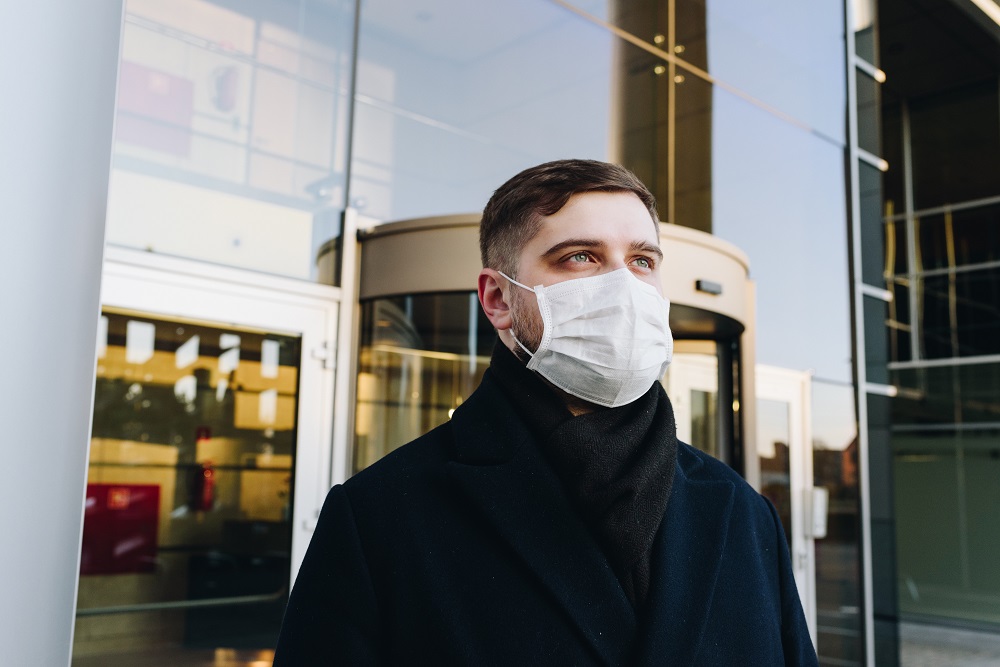The UK opened up after a series of lockdowns due to the COVID-19 pandemic in July, right in the middle of when the country had the highest number of cases recorded around the world. While the citizens seemed to rejoice, the dark cloud of the Delta variant loomed large.
The COVID-19 vaccine drives were on in full force. The death count reduced drastically, but the number of cases just didn’t seem to drop. The vaccine wasn’t protecting the citizens from the new variant, it was merely reducing its impact. The government implemented various strategies to combat this problem and give the UK economy a chance to recover, which gave rise to the ‘pingdemic’.
People around the country were notified to stay indoors if they happened to be in the proximity of someone who ended up testing positive for COVID-19. In theory, this practice was great. It was the most precautionary measure that the government could take without going into another lockdown but this had a severely negative impact on the UK economy.
How is that?
The Pingdemic and its Impact on the UK Economy in 2021
The pingdemic has managed to disrupt the operational flow of many industries since the UK economy finally opened up. The guidelines released by the UK government were not mandatory but they came heavily recommended. When the country opened up there were a record-breaking number of cases every day. This meant that there was always a high chance that you would come in contact with someone who would end up testing positive for COVID-19, either directly or indirectly.
To be on the safer side, employees of companies in various labor-intensive or people-centric industries such as manufacturing, retail, production, and more chose to stay at home and quarantine if they were alerted. This meant that there was always a shortage of employees who could work regularly. This caused an upheaval in terms of production and delivery because companies were always understaffed.
As the UK economy tried to recover from the last year of misfortune, the demands kept rising, but the number of people who were active in the workforce kept diminishing. The scenario got worse over the next few months as the global demand rose, not just in the UK, and there was a global shortage of the most basic resources and raw materials.
In the UK, people were looking forward to going out on vacation, making purchases, and experiencing some sense of normalcy in their lives. But this disruption did not allow them to do so.
Even today, months after the government decided to open up the economy, the number of cases is still quite high. Up until September, there were no more than one or two days where the total number of reported cases for COVID-19 positive patients fell below 30,000 (GOV. UK).

It feels like the country is fighting a losing battle that is never going to end. The COVID-19 vaccine drives, all the precautionary measures, and the rapid testing and hospitalization are simply not enough as of now. This situation could mean that the end of the COVID-19 pandemic is nowhere near. The UK might very well go well into the first quarter of 2022 battling the losses from the pandemic.
This will obviously have an enormous negative impact on the UK economy. The GDP rate for 2021 surpassed expectations when it rose to 6.8% (Nation Institute Of Economics and Social Research) instead of the predicted 5.7%. Since the demand was incredibly high which was a surprise since the country was still quite unstable, the quantum of money the citizens spent once the UK economy opened up was significantly higher than what was expected.
Another factor that helped increase the GDP of the country was the rising cost of resources. The government realized that the existing supply and output of resources does not meet the current demand so they had to increase the prices of basic necessities such as natural gas, electricity, heating, and fuel. Currently, the UK economy is experiencing a big shortage due to the global disruption in the supply chain and production, which is a cause for worry. It may lead to higher inflation rates and put the country into a recession.
The COVID-19 Pandemic Marches On Towards the End of 2021
The year may be coming to an end, and we will soon mark the second year since the pandemic officially started and was declared a global emergency, but COVID-19 is nowhere close to coming to an end.
Currently, there are four main variants of concern in the world. They have been categorized based on the Greek alphabet – Alpha, Beta, Gamma and Delta. The WHO has created a system to track variants and divide them into two categories. The two categories are VOC, which are the Variants of Concern and VOI, which are the Variants of Interest.

Variants of Concern are the four main variants mentioned above. They have a high transmission rate and are considered to affect countries all around the world. The VOCs are the ones the COVID-19 vaccine was developed to combat because these are the variants responsible for the majority of the deaths around the world. Since the COVID-19 vaccine was developed and released right around the time the Delta variant was created, the efficacy rate of the vaccine is doubtful.
This is why countries everywhere are still apprehensive about the end of the COVID-19 pandemic. The Delta variant is fairly new but it has the fastest transmission rate. The vaccine helps reduce the severity of the symptoms in patients to an extent, but it is in no way a cure or a solution. People are still badly hit with the Delta variant of COVID-19, and the vaccines are not always effective on everyone. Remember, the vaccine is still very new which means that it hasn’t been perfected yet. It isn’t a one-for-all solution.
The Delta variant was the main reason why many countries around the European continent and the Australian continent went into more lockdowns; because they wanted to eliminate any chances of the virus spreading to the same extent as that in 2020 again. The Delta variant of the COVID-19 virus is the reason the ‘pingdemic’ is taking place. The Delta variant is the reason there is a shortage of supply of various raw materials and parts in the market. It is also the reason why there is so much confusion and backlog in the supply chain industry.
Basically, most of the problems that exist today on a macro scale – both in terms of economy and resources, are due to the Delta variant. Countries, governments, and research organizations are working very hard at tracking any possibilities of a new variant that could rise and disrupt the world even more.
This is why there is a second category created by the WHO. The Variants of Interest or VOIs are marked as possible variants in the form of mutations in the existing strains of the virus. They are then tracked by scientists in the place where the mutations are found to check for severity, disease escape, and the chances of it becoming a global risk to the general public.
Researchers, scientists, health organizations and governments are all on high alert consistently tracking the progress of the virus. By understanding the virus, its mutations, and its effect better, it will become easier to find a cure. Clearly, it is still a time of unrest as the second year of the pandemic comes to an end. Even if the world is opening up, there is still a long way to go before we can truly enter the post-pandemic world.
Other Risks of COVID-19
The biggest risk currently is the children who have not been vaccinated. Vaccination drives started with treating those who were most likely to get severely affected with the virus if they caught it. This list included public workers, healthcare professionals, people who were advanced in age and those with various comorbidities that would put them at risk of death.
Then, the vaccination drives included the working force of the society. Labourers, employees, employers, and everyone between the age of 18 and 50 who could contribute to the market gainfully got vaccinated. This was to help open up the world and regain some sense of normalcy. The economic backlash of the pandemic was severe and governments around the world scrambled to do the best they could to reduce the damage it had caused. The COVID-19 vaccine drives went on in full swing, and as more and more people ended up getting vaccinated, more industries around the world started to open up.
Businesses and industries finally became operational, and the death count began to reduce. But, there is one category that hasn’t had the benefit of the COVID-19 vaccine yet. It’s the children. Kids under 18 haven’t been a part of this aggressive vaccination drive, which makes them more at risk than any other age group today.
There are only a few countries around the world that have started vaccinating children, and this is only a recent development. The UK approved COVID-19 vaccines for kids between the ages of 12 and 15 in mid-September, which is no more than a few weeks ago. Only a few countries around Europe such as Denmark, Spain, France, Germany, Sweden and Norway are open to vaccinating children. These vaccinations also come with their own set of conditions attached, differing from country to country.
Kids are going back to school, attending on-premise classes, and going about their lives without any form of protection against the very prevalent COVID-19. This puts them at a big risk of infection. Even though they might have strong immunity and could survive the fallout from the vaccine, they could infect others who may not be as lucky. Not to mention that kids under the ages of 12 are not even getting considered eligible for the COVID-19 vaccine except in China and Chile.
Reasons Behind Why Countries are So Hesitant to Vaccinate Children
There are two main reasons behind why children haven’t been vaccinated so far and they are still considered to be a low priority for the vaccine rollouts. The first reason is that children respond to the COVID-19 virus differently than adults. They have higher resilience to the virus and are the least affected age group in any given population size.
The second reason is that children are also considered to be the vulnerable population. Since their immunities and immune responses have not been fully developed, they are at a much higher risk of getting affected by the side effects. Specialists need to be a lot more cautious and do more research to deem these vaccines safe for kids.
The younger the children are, the more likely they are to react badly to the vaccine. And since their age group isn’t that vulnerable to the virus anyway, they weren’t considered a priority. Now, with the Delta variant wreaking havoc in countries around the world, children are getting affected too. The transmission rate of this variant is so high that it has started affecting children as well. This is why researchers and specialists have focused their energy on making sure that the COVID-19 vaccine is safe for children.
Read also: Third Wave of COVID-19 – What Does it Mean for the UK Economy?
COVID-19 and the UK Economy – Predictions for 2022
The inflation rate managed to jump by 1.2% in just a month. This only adds to the rising fear of a recession for the UK economy. The Consumer Price Inflation rate (CPI) made the biggest leap in history in the shortest time period, jumping from 2% in August to 3.2% (S&P Global) in September.
While market research services and specialists speculate that the inflation rate won’t rise anymore, it all depends on the market and consumer behaviour. The momentum that starts with panic is often difficult to dissuade and end. So predicting the future market trends, inflation rate, and the GDP of the UK economy becomes all the more difficult to do. Ideally, the rising rate of inflation should get more stabilized with the increase in the pay growth rate as well, and the first quarter of 2022 should start a bit more smoothly.
The disruptions in the labour market, the rising prices of fuel, heating and electricity, the shortage of natural resources, and the high number of COVID-19 cases are points of worry that could continue to affect the UK economy negatively. While there is nothing that the government can do, the UK citizens can offer assistance in the matter.
How can the UK Citizens Help?
Safety and prevention are better than cure. Citizens can do their bit to prevent the spreading of this virus by being careful, following social distancing when they are in public, wearing their masks, and regularly getting tested to make sure they are safe from the virus.
Another way the citizens of the UK can help is by not giving in to the mob mentality driven by fear today and stay calm in times of crisis. This way there won’t be as many shortages of supplies, and the inflation rates will drop. Increasing panic will only result in a rise in inflation. If this problem is not addressed adequately, it might actually result in the UK economy dealing with a recession towards the end of 2022.
The UK citizens need to be careful and mindful of their actions in order to create the best possible outcome for the country in the coming year.









